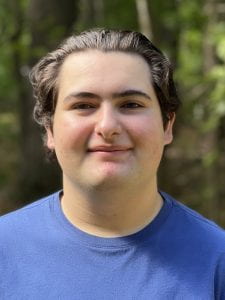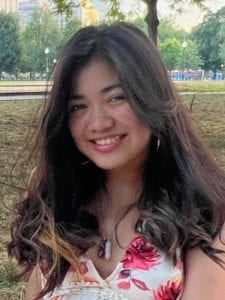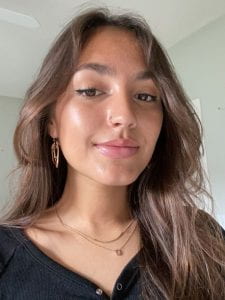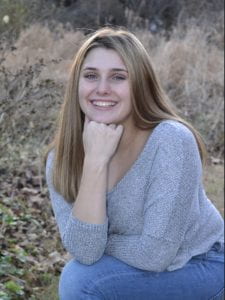by Emma Kennedy
Emma is a Latin American and Iberian Studies major with a minor in Secondary Education from Ipswich, MA. She has always been intrigued by languages, language barriers, and language learning throughout her studies. She was intrigued to “read about people who have the opposite perspective, who oppose multilingual education, and want their children to focus on perfecting their English.” Emma wants to be a teacher, focusing on multilingual students. She feels that her paper’s connection to her career “made the researching and writing process feel more interesting and relevant to her real life.” Emma enjoys reading and uses it as a way to practice Spanish — she is now using the same tactic for French. She loves to try new foods from all over the world and bake sweets from different countries. In her spare time, she likes origami and has made several thousand origami cranes throughout the years.
Education has always aroused great passions and debate. As one of the fundamental pillars upon which our society is built, a system to which each and every one of us must dedicate more than a decade of our lives, it is impossible for it not to take a central role in our country’s discourse. And yet, sometimes it feels like we have lost sight of the bigger picture and turned education into the battleground for a culture war. From what to teach, to who to allow in, all aspects of American public education are up for debate, and language education is no exception. Across the country, millions of students are learning English as a second language, and millions more students are studying languages other than English. Language education has always been a part of American education, but, as the cliché goes, in today’s increasingly globalized world, it is more important than ever. I, for one, went to a monolingual school and never had the opportunity to study a second language until I was much older, and I’ve always regretted this. Now, as I am studying education and hoping to become a public-school teacher, I have come in contact with the other side of the issue – which is that many non-English speaking students are underserved by our education system. It is society’s responsibility to ensure that our students, all our students, are given the tools they need to be successful in today’s globalized world, and it seems to me that we are failing in this essential mission. Despite a general consensus that language education is essential, there is quite a lot of disagreement about who should receive what instruction, and how it should be given. These are questions we need to answer in order to begin addressing the problems in our society.
When we discuss language education in the United States, we usually sort students into two categories: children from immigrant families who are learning English, and children from native English-speaking families learning other languages. While both groups are language learners, their circumstances are vastly different, and consequently they have very different needs. First, let’s look at English language learners (ELLs). ELLs can be classified in many different ways, but they are usually immigrants, or the children of immigrants, who learned a language other than English prior to entering the American school system and are not considered ‘proficient’ or ‘at grade level’ in English. Legislation dating back to the Civil Rights Movement in the 1960s requires that schools provide support for ELLs, which usually takes the form of some type of ‘bilingual education,’ but the exact approach, and the reported success or failure, varies widely depending on the district or even the individual school.
But what, exactly, is bilingual education? Well, the answer depends on who you ask. Ellen Bialystok, a researcher in the field of bilingual education, gets to the essence of the issue in her article titled “Bilingual Education for Young Children: Review of the Effects and Consequences.” This article, published in the International Journal of Bilingual Education and Bilingualism, synthesizes a multitude of previous studies to discuss the pros and cons of bilingual education, as well as the factors that interfere with its study. She points out that, for one researcher whose work she reviewed, bilingual education means “education that aims to promote bilingual (or multilingual) competence by using both (or all) languages as media of instruction for significant portions of the academic curriculum” (Genesee qtd. in Bialystok 667). But for another, it means “teaching non-English-speaking students to read and write in their native tongue, teaching them content in their native tongue, and gradually transitioning them to English over a period of several years” (Rossell and Baker qtd. in Bialystok 667). According to the latter definition, the goal is fluency in English, while according to the former, the goal is fluency in English and another language. These are two very different goals, and they imply very different approaches, to the extent that I would argue we need to be using two different terms, lest we get confused. For this reason, I propose the use of two different terms, dual language education for the former (when the goal is fluency in multiple languages) and transitional language education for the latter (when the goal is fluency in English), with bilingual education being the umbrella term used to refer to the education of anyone who speaks, or would like to speak, two languages. While both “dual language education” and “transitional language education” are both terms already in use, this use is very limited, and I think it would be appropriate for everyone to adopt them. This way, we can be precise in what we are referring to, which will help avoid harmful misunderstandings resulting from ambiguous and confusing terminology.
Because, people do get confused! In an anonymous survey on K-12 educational experiences that I conducted in April 2022, of 44 undergraduate students at UMass Boston, 17 of 44 said that there were “multiple languages of instruction” at their school, meaning that non-language curriculum was taught in more than one language. This is what most people, regardless of what they believe the goal of bilingual education should be, would consider a bi/multilingual school. However, when these same 17 were asked: “What was the percentage of classes delivered in English versus another language?” and given a scale (from 1 to 5, with 1 being “all English” and 5 being “all another language”), 9 respondents selected 1 (“all English”) and 1 selected 5 (“all another language”). Only 3 of the 17 selected 3, which would represent an equal split between two languages (Kennedy 2022). These respondents considered their schools bilingual schools, and yet, under the official definition of bilingual education that is used by federal, state, and local governments to make policy and allocate funding, there is usually a requirement that the split between languages of instruction be something along the lines of 50%/50% or 40%/60%. These percentages acknowledge that the exact terminology and phrasing varies, just like all other aspects of this topic seem to. Further complicating this discussion, I find it very interesting that people’s understanding of what is or is not considered bilingual education is so variable. The survey participants come from one small group of college students, and yet even within these 17 people there is a wide variety of understanding about what ‘bilingual education’ is. As someone who would like to work in bilingual or language education in the future, I would like to know exactly what type of school I am applying to before I show up on the first day – since clearly ‘bilingual’ doesn’t tell me much. This is why I propose the widespread and standardized usage of different terms, such as dual language education and transitional language education, for different approaches and goals.
It is my belief that this ambiguity regarding what the term ‘bilingual education’ means, and what its goals are, is a main reason that the research on bilingual education is so full of contradictions. For instance, I saw firsthand how the discrepancy in understanding what bilingual education means can affect research when I made my survey. To me, bilingual education means dual language education, with students who are actively taught two languages, and then these two languages are used to teach non-language curriculum, such as history or math. In my mind, being ‘bilingual’ also implies a measure of equality between the two languages, meaning that similar amounts of time and energy and prestige are dedicated to each…although, now that I think about it, I’m actually not sure why I feel this way, since when I think of a bilingual person, I don’t necessarily think of someone who carries out exactly half their day in one language and half in another—it’s just someone who is able to use both but may choose not to. This makes me wonder, should we have yet another term to describe education that is equally split between two languages, since bilingual education in itself doesn’t necessarily mean this? Or is simply adding “50/50” or “40/60” to the name sufficient? I don’t have a definitive answer for this question, there is such a thing as having too much jargon after all, but I think it is something for researchers, educators, and other stakeholders to explore further. In any event, there is no doubt that the definition of bilingual education that I have in my head affected the way I organized and worded my survey, which undoubtedly affected the results I got. For example, I neglected to define what I meant by ‘bilingual,’ and ‘multilingual,’ and so people responded according to what their definitions were, which may be different than mine. I assume this was why I got such confusing responses, such as the aforementioned group that said they went to a bilingual school but had all their classes in English. Perhaps if society had already adopted different terms for the different models, I would not have had this issue.
In any case, while some of the issues with my survey are no doubt due to my inexpertise in research and survey creating, I have good reason to believe that misunderstandings related to what bilingual education is, and what it should do, are a common plague in research and discourse relating to the topic. Indeed, when writing in the journal Educational Review, Yoon Kyong Kim, Lindsey A. Hutchison, and Adam Winsler, who have done extensive research in the field of bilingual education, include a sort of ‘disclaimer’ in the introduction to their article, titled “Bilingual Education in the United States: An Historical Overview and Examination of Two-Way Immersion,” which provides a review of the history and effectiveness of two-way immersion (a type of dual language education). They state that “wide variability in educational services for ELLs creates difficulty for researchers and practitioners attempting to assess the effectiveness of these services” and point out that “programs in which ELL children are mainstreamed into all-English classrooms, programs where ELLs receive instruction in both English and Spanish, and programs in which all students (both ELLs and native speakers of English) are instructed in both English and Spanish, are all described as ‘bilingual education’” (Kim, et al. 237). These authors capture in words what so many other studies dance around or only hint at, perhaps fearing that admitting uncertainty or ambiguity would lessen their credibility or the validity of their research. Although I would argue the opposite: that not admitting the presence of ambiguity and/or uncertainty hurts their study far more, since the result is that we end up with a bunch of studies that claim to have studied ‘bilingual education’ (whatever that’s supposed to mean) and that all have totally different, and often contradictory, conclusions about the effectiveness of the practice which arises from the fact that neither the definition nor the goal is clearly and universally defined. This type of inconclusive research, resulting from issues with terminology, is, at best, a waste of money, and at worst, harmful, as it leads people to draw incorrect conclusions about the best way to educate people.
So, if our inability to agree upon an exact definition for bilingual education affects the way we do research and the purported outcomes of that research, now we must wonder, does it affect anything else? The answer is, without a doubt, yes. One observation of particular interest is the inconsistency between what the researchers and educators say and what the parents and politicians say. Of course, these groups are not homogenous, and there is crossover and differences of opinion between them, especially in the case of parents. Nevertheless, overall, there seems to be a tendency for researchers to favor dual language education, while many parents, particularly Latinx and Asian parents, prefer more of an emphasis on education in English or transitional language education only (Pedalino Porter). This is a complex issue and there are undoubtedly multiple factors at play, but at the heart is the years-old debate over whether learning another language hinders students’ development in English. The research tends to say no, at least when separated from other confounding factors such as socioeconomic status, but parents are still worried. As Arthur Vasquez, a parent of two, puts it, ”I don’t deny my heritage as a Mexican-American, but the reason that we have achieved what we have in this country is that we speak English” (Fiske). Vasquez, and parents like him, believe that English is the key to success in this country, and therefore they worry that studying a heritage language is a waste of time that could otherwise be used to improve their children’s English. However, researchers reject this conclusion. Bialystok, for example, refutes this idea quite strongly in her meta-analysis of a multitude of studies regarding outcomes for students in monolingual and bilingual programs, finding that:
Scores on the English proficiency test were higher for both ELL and EP students who were in the bilingual programs than they were for children in the mainstream English programs. Similar results were found for scores on the mathematics test. Overall, students in the dual language program in this low socioeconomic status (SES) community achieved at least as well and in some cases better in both English and mathematics than did comparable students in a program in which all instruction was in English. Students in the bilingual programs also made more rapid progress across the grades in these tests than did students in the English program and, therefore, were more advanced in their trajectory to close the achievement gap with statewide norms for these tests. (Bialystok 668)
In other words, students’ English did not suffer as a result of being educated bilingually, and the cognitive and educational benefits of bilingual programs were actually greater than those of monolingual programs.
In light of this, both Vasquez and Bialystok’s points are valid. As Vasquez points out, there is no doubt that English, as the majority language, is an important tool for success in the US—and researchers agree on this point; certainly no one is arguing against the teaching of English. Instead, what the researchers are arguing is that, since dual language education in itself, when separated from socioeconomic status or years in school, does not harm, and may actually support, students’ abilities in English in the long run. The fear of weaker English proficiency is not a valid reason to oppose it. On the contrary, seeing as dual language programs lead to equal amounts of learning in math and English as monolingual programs, students in these programs end up with the advantage of being fluent in multiple languages, a coveted ability in our multicultural country and world. Therefore, researchers stress that, while not perfect, one could argue that nothing in our current education system is perfect, dual language education provides a net benefit over monolingual education. This conclusion is substantiated by every research study and scholarly article I have reviewed.
And yet, parents still worry and, as a result, politicians still claim that dual language education is harmful. I would argue that these concerns are not the result of an actual failure or inherent fault of dual language education, but rather a collection of problems in implementation that generates the appearance that dual language education is harmful, when in fact it in itself is not the culprit. For instance, Edward Fiske, while arguing against bilingual education in a New York Times Op-Ed titled “The Controversy over Bilingual Education in America’s Schools; One Language or Two?,” mentions cases of “Vietnamese immigrants being put into classes where the teaching language was Spanish” and “English-speaking students whose real need is remedial help in their native language [which is English] being forced to learn in a strange tongue” in a dual language program. Fiske, as well as Rosalie Pedalino Porter, a writer for The Atlantic who penned another article opposing bilingual education called “The Case Against Bilingual Education,” cite a multitude of instances of school administrators forcing all students from Spanish-speaking families into dual language programs and even refusing to teach reading and writing in English until they had ‘mastered’ Spanish in late elementary school, even if the students were native English speakers and their parents wanted them in the monolingual program. These types of occurrences, from bungling student placement to deliberately and obstinately going against parents’ wishes, simply do not endear schools, and the programs they implement, to parents, and so it makes sense that parents oppose them. In cases like this, it is not what is actually happening that is important, but rather what people think is happening. Education is a topic that brings out people’s passions, and in this case, it seems that people’s passionate concern for their children’s education may in fact be getting in the way of that education.
In short, there is no doubt that we, as a society, must make the effort to educate all of our students equitably. What is up for debate is how we should educate our students, especially language minority and ELL students, who face additional barriers to receiving an adequate American public education. It is the how we must figure out if we wish to keep moving our society forward into the 21st century and give our students the tools they need to succeed in our world. One way we can do this is by bringing some form of bilingual education to them. As a person who grew up monolingual and feels very regretful about that fact, it is my hope that one day all students will have the opportunity to access the benefits of dual language education, no matter if they come from an English-speaking background or another language background.
Works Cited
Bialystok, Ellen. “Bilingual Education for Young Children: Review of the Effects and Consequences.” International Journal of Bilingual Education and Bilingualism, vol. 21, no. 6, Routledge, 2018, pp. 666–79.
Fiske, Edward B. “The Controversy Over Bilingual Education in America’s Schools; One Language or Two?” New York Times, 10 Nov 1985.
Kennedy, Emma. “Multilingual Education.” Student Questionnaire. April 2022.
Kim, Yoon Kyong, et al. “Bilingual Education in the United States: An Historical Overview and Examination of Two-Way Immersion.” Educational Review (Birmingham), vol. 67, no. 2, Routledge, 2015, pp. 236–52.
Pedalino Porter, Rosalie. “The Case Against Bilingual Education.” The Atlantic, 1 May 1998.













